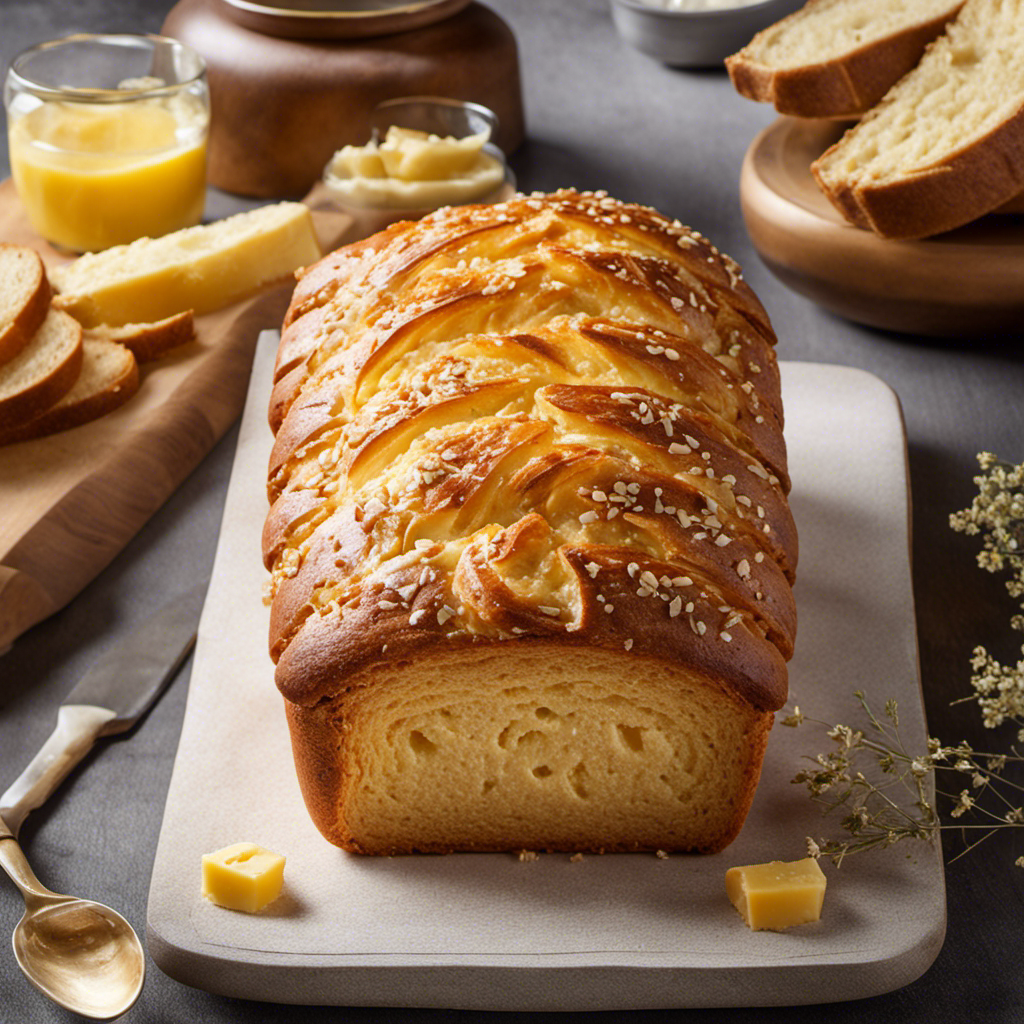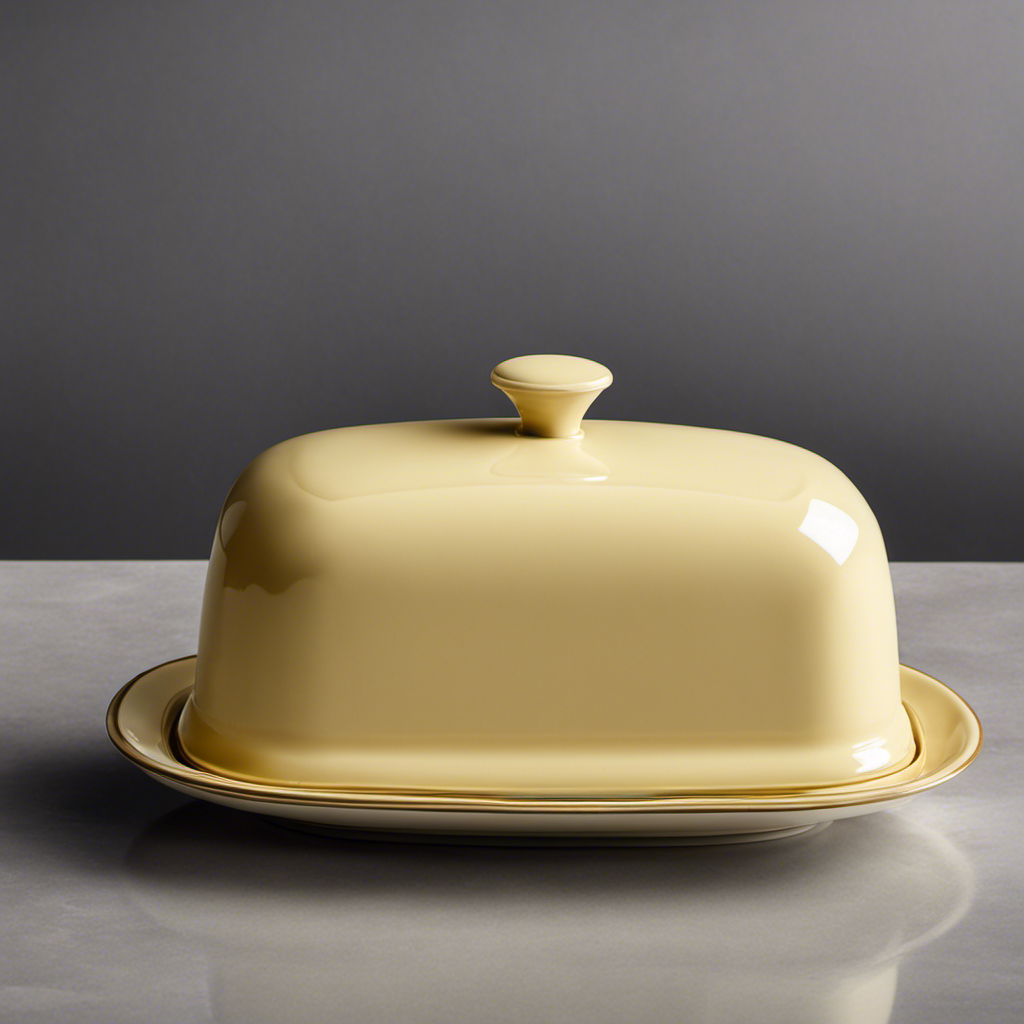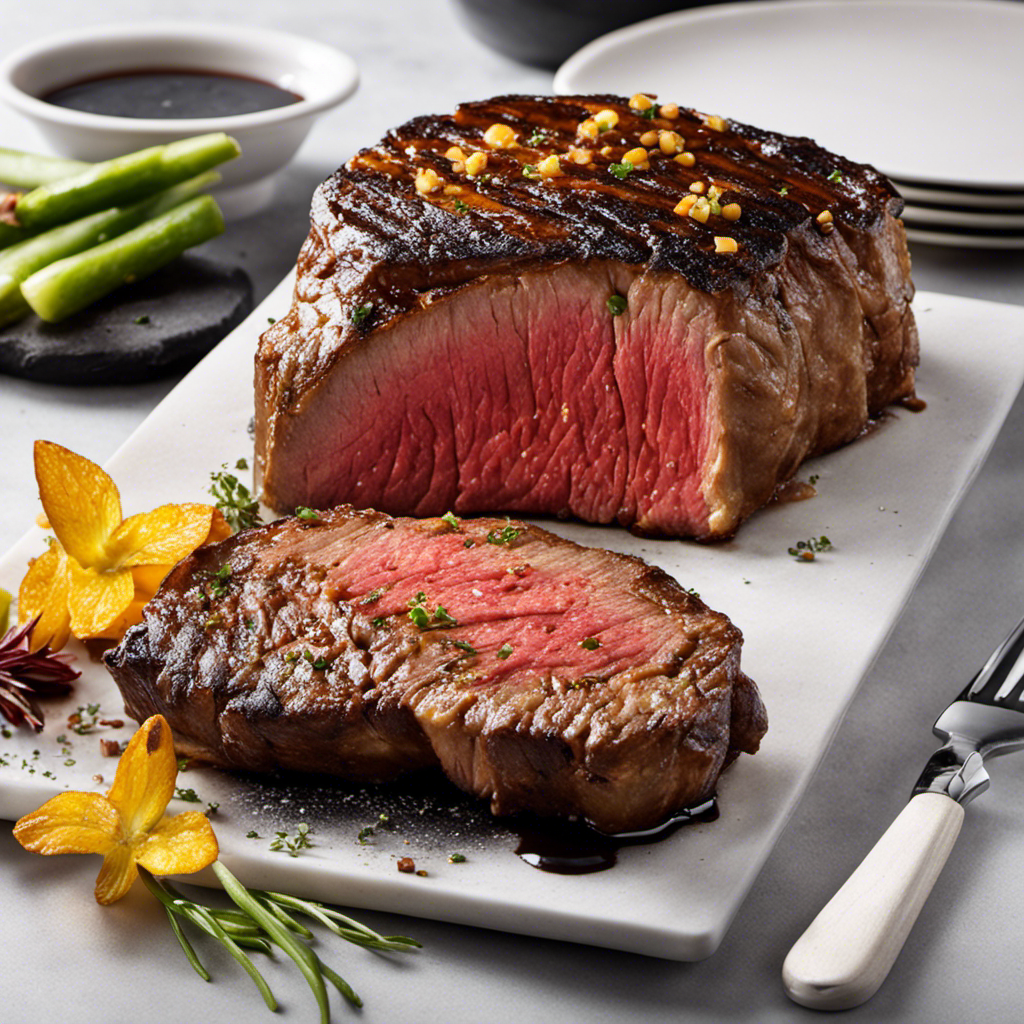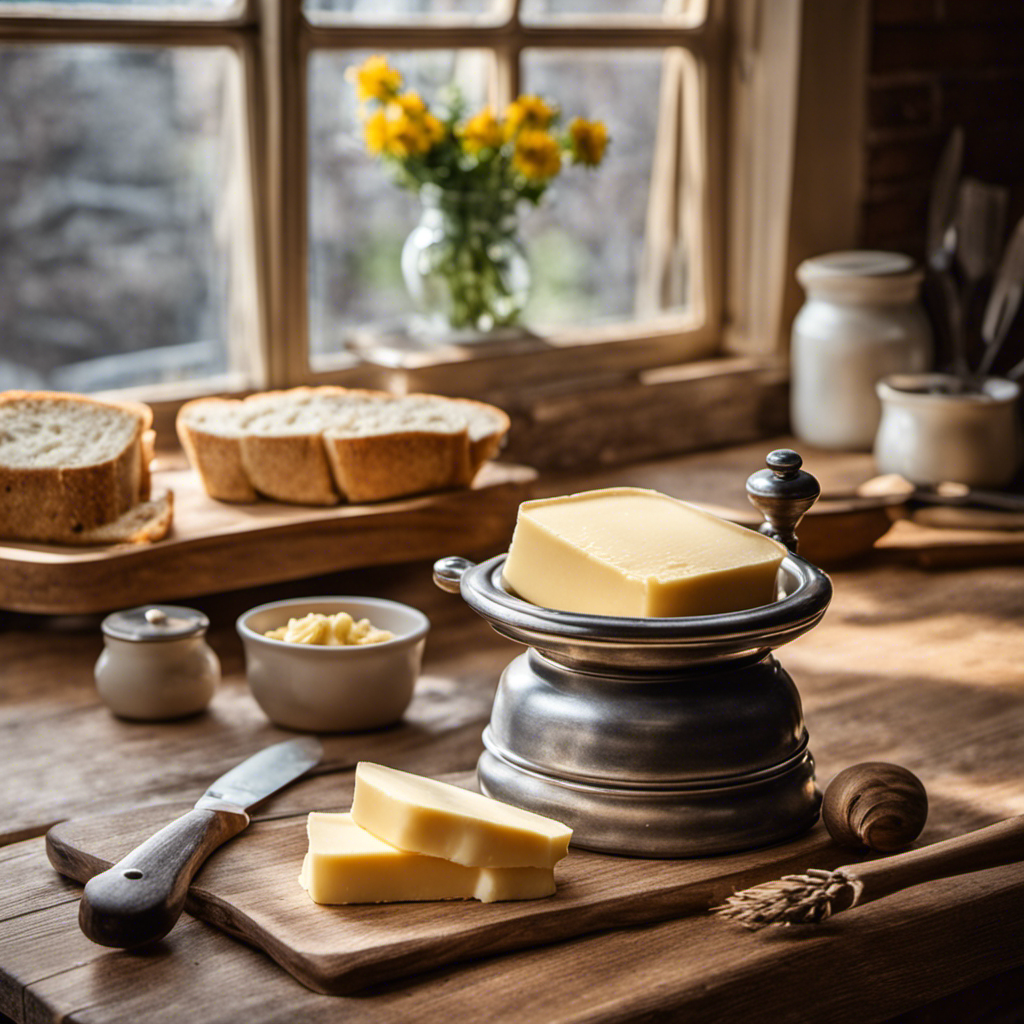When I indulge in a bite of a warm slice of bread generously spread with creamy butter, I am filled with a deep sense of satisfaction. Have you ever stopped to consider what makes this simple combination so irresistible?
In this article, I will delve into the historical significance, the science behind the perfect pairing, and the cultural importance of bread and butter. Join me on this journey as we uncover the secrets behind why bread and butter have become a staple in every household.
Get ready to discover the magic of this humble yet extraordinary duo.
Key Takeaways
- Bread and butter have deep cultural roots and are significant in many culinary traditions.
- The combination of bread and butter is satisfying to our taste buds due to the chemistry behind it.
- When consumed in moderation, bread and butter can be part of a healthy diet.
- Making homemade bread and butter allows for personalized flavors and a sense of accomplishment.
The Historical Significance of Bread and Butter
The historical significance of bread and butter cannot be underestimated.
Bread has been a staple food for centuries, with its origins dating back to ancient times.
The simple combination of bread and butter has deep cultural roots and holds a special place in many culinary traditions around the world.
Bread symbolizes sustenance and nourishment, while butter adds richness and flavor.
The historical origins of bread and butter can be traced to various regions, each with its own unique cultural traditions.
From the crusty baguettes of France to the fluffy white bread of America, bread and butter have evolved to become a symbol of comfort and familiarity.
Understanding the historical and cultural significance of this humble pairing helps us appreciate its timeless appeal.
The Science Behind the Perfect Bread and Butter Combination
One can’t deny the science behind the perfect combo of bread and butter. The chemistry behind bread and butter is a fascinating subject that explains why this combination is so satisfying to our taste buds.
Bread, with its complex carbohydrates, provides a neutral base that complements the rich flavors of butter. When we bite into a slice of bread slathered with butter, our taste receptors are activated by the combination of salty and creamy sensations. This sensory experience is enhanced by the Maillard reaction, a chemical reaction that occurs when the bread is toasted and the butter melts, creating a delicious aroma and golden brown color.
Understanding the science behind the perfect bread and butter combination allows us to appreciate the culinary magic that takes place in our mouths.
Transitioning to the next section, let’s now explore the cultural importance of bread and butter.
Exploring the Cultural Importance of Bread and Butter
Take a moment to consider how bread and butter have become integral components of various cultural cuisines around the world.
Cultural traditions and global variations have shaped the way bread and butter are enjoyed in different societies. In France, for example, freshly baked baguettes are often served with a generous slab of creamy butter, creating a delightful combination of textures and flavors.
In India, naan bread is commonly served with ghee, a clarified butter, adding richness and depth to the meal.
Meanwhile, in Japan, butter is used in a variety of sweet and savory dishes, from melon bread to corn butter ramen.
These examples highlight the versatility of bread and butter, as well as their ability to adapt to different culinary customs and preferences across the globe.
Health Benefits of Including Bread and Butter in Your Diet
When it comes to the nutritional value of bread and butter, there are several key points to consider.
First, bread is a good source of carbohydrates, providing energy for the body. Additionally, it contains essential vitamins and minerals such as B vitamins and iron.
On the other hand, butter is high in saturated fat, which is a concern for heart health. However, it also contains vitamins A and E, as well as healthy fatty acids.
Overall, when consumed in moderation, bread and butter can be part of a healthy diet.
Nutritional Value of Bread and Butter
The nutritional value of bread and butter is often overlooked.
Bread has been a staple food for centuries, with evidence of its consumption dating back to ancient civilizations. Similarly, butter has been enjoyed for its rich taste and creamy texture throughout history.
The combination of bread and butter has deep cultural significance in many societies, symbolizing comfort, nourishment, and hospitality.
However, beyond its cultural importance, bread and butter also provide essential nutrients. Bread is a good source of carbohydrates, dietary fiber, and B vitamins, while butter contains healthy fats and fat-soluble vitamins.
When consumed in moderation and as part of a balanced diet, bread and butter can contribute to overall health and well-being.
Now let’s explore the specific health benefits of including bread and butter in your diet.
Health Benefits Explained
Including bread and butter in my diet can contribute to my overall health and well-being by providing essential nutrients.
Bread is a good source of carbohydrates, which are the body’s main source of energy. It also contains fiber, vitamins, and minerals, depending on the type of bread.
Butter, on the other hand, is high in saturated fat and should be consumed in moderation. However, it does provide some health benefits. Butter contains fat-soluble vitamins like vitamin A, D, E, and K, which are important for various bodily functions. It also contains conjugated linoleic acid (CLA), which has been shown to have anti-cancer and anti-inflammatory properties.
When consumed in moderation and as part of a balanced diet, bread and butter can be a tasty and nutritious addition to one’s meals.
The Art of Making Homemade Bread and Butter
Making homemade bread and butter is a great way to elevate your culinary skills. Not only does it allow you to create delicious and personalized flavors, but it also gives you a sense of satisfaction and accomplishment. Here are four reasons why you should try your hand at making homemade bread and butter:
-
Homemade Bread Recipes: Experimenting with different bread recipes allows you to explore a variety of flavors, textures, and ingredients. From classic sourdough to hearty whole wheat, the possibilities are endless.
-
Butter Making Techniques: Making your own butter gives you control over the ingredients and allows you to customize the flavor. Whether you prefer salted or unsalted, creamy or tangy, you can create a butter that suits your taste.
-
Artistic Expression: Baking bread and making butter is an art form. It allows you to express your creativity through shaping the dough and experimenting with flavors. Each loaf and batch of butter becomes a unique masterpiece.
-
Connection to Tradition: Making homemade bread and butter connects you to the rich culinary traditions of the past. It is a way to carry on age-old techniques and pass them down to future generations.
Unveiling the Secrets of the Best Bread and Butter Pairings
When it comes to creating an unforgettable culinary experience, perfect flavor combinations are key. By carefully selecting ingredients that complement and enhance each other, we can elevate the taste profiles of our dishes to new heights.
However, it’s not just about sticking to traditional pairings; exploring unconventional combinations can lead to delightful surprises and open up a world of exciting flavor possibilities.
Perfect Flavor Combinations
One of the reasons bread and butter is so good is because of the perfect flavor combinations. These combinations enhance the taste profiles and take the simple act of spreading butter on bread to a whole new level.
Here are four enticing combinations that will make your taste buds dance:
-
Sweet and Salty: Spread a generous amount of creamy butter on a warm slice of freshly baked bread and top it with a sprinkle of sea salt. The contrast of sweet and salty flavors creates a delightful harmony.
-
Herbs and Butter: Mix finely chopped herbs like basil, rosemary, or thyme into softened butter. Spread this flavorful concoction on a crusty baguette or a slice of sourdough for a burst of aromatic goodness.
-
Spicy and Tangy: Kick things up a notch by adding a dash of hot sauce or a squeeze of lime juice to your butter. Spread it on a hearty whole grain bread for a zesty and tangy kick.
-
Fruity and Buttery: Pair a fruity preserve, like raspberry or apricot, with creamy butter. Spread this luscious combination on a slice of brioche or a flaky croissant for a taste sensation that is both sweet and buttery.
These perfect flavor combinations elevate the humble bread and butter to a whole new level of deliciousness.
Enhancing Taste Profiles
Now that we have discussed perfect flavor combinations, let’s delve deeper into exploring flavor profiles and taste enhancement techniques.
When it comes to bread and butter, understanding how different flavors interact and complement each other is essential in creating a delightful experience for our taste buds. By exploring flavor profiles, we can identify the unique characteristics of both the bread and the butter.
A crusty baguette, for example, offers a nutty and slightly sweet taste, while a creamy butter provides a rich and velvety texture. To enhance these flavors, various techniques can be employed, such as adding herbs or spices to the butter, or experimenting with different bread types like sourdough or rye.
These techniques allow us to elevate the taste profile of bread and butter, transforming a simple combination into a truly satisfying culinary delight.
Unconventional Pairings Explored
To truly elevate your culinary experience, you’ll be surprised at the delightful combinations you can create by exploring unconventional pairings. Flavor experimentation is a thrilling way to expand your palate and discover new taste sensations. Here are four unconventional pairings that might just surprise you:
-
Dark chocolate and blue cheese: The rich, velvety sweetness of dark chocolate pairs surprisingly well with the salty, tangy notes of blue cheese. It’s a harmonious blend of flavors that will leave your taste buds begging for more.
-
Watermelon and feta cheese: The juicy, refreshing sweetness of watermelon perfectly complements the creamy, salty taste of feta cheese. This unlikely duo creates a burst of flavors that is both unexpected and delicious.
-
Bacon and maple syrup: The smoky, savory flavor of bacon is elevated to new heights when paired with the sweet, caramel-like taste of maple syrup. It’s a match made in heaven that will leave you craving for more.
-
Avocado and chocolate: The creamy, buttery texture of avocado lends itself well to the rich, indulgent taste of chocolate. This unconventional pairing creates a decadent dessert that is both creamy and satisfying.
How Bread and Butter Became a Staple in Every Household
Bread and butter became a staple in every household due to its versatility and delicious taste. Over the years, the popularity of bread and butter has risen steadily, making it a common choice for breakfast, lunch, and dinner. Its simplicity and affordability have contributed to its widespread appeal.
Cultural traditions surrounding bread and butter consumption further highlight its significance. In many cultures, bread is considered a symbol of sustenance and is often used to accompany meals or as a vessel for other ingredients. Butter, on the other hand, adds richness and flavor to bread, enhancing its overall taste.
Whether it’s enjoyed as a morning toast or used as a base for sandwiches, bread and butter have become a go-to option for people of all ages and backgrounds. Its ubiquity in households is a testament to its enduring popularity and the comfort it brings to our daily lives.
Frequently Asked Questions
How Many Calories Are in a Serving of Bread and Butter?
I’m not sure about the exact number of calories in a serving of bread and butter, but there are alternatives available for those with lactose intolerance. It’s important to consider these options for a healthier diet.
What Is the Best Type of Bread to Use for Making Homemade Bread and Butter?
The best bread for making homemade bread and butter is typically a hearty, crusty loaf like a baguette or sourdough. These breads have a chewy texture and complex flavors that enhance the rich creaminess of the butter. Plus, making your own bread has the added benefits of controlling ingredients and freshness.
Can Lactose-Intolerant Individuals Still Enjoy the Benefits of Bread and Butter?
Yes, lactose-intolerant individuals can still enjoy the benefits of bread and butter by opting for lactose-free options. These options provide the same delicious taste and health benefits without causing any discomfort or digestive issues.
Are There Any Alternatives to Butter That Can Be Used in Bread and Butter Combinations?
There are alternative spreads available for those seeking dairy-free options in bread and butter combinations. These spreads can provide a similar taste and texture, allowing lactose-intolerant individuals to still enjoy the benefits.
How Does the Quality of Butter Affect the Overall Taste of Bread and Butter?
The quality of the butter greatly affects the overall taste of bread and butter. Higher quality butter enhances the flavor, making it richer and more satisfying. Inferior butter can result in a less enjoyable experience.
Conclusion
In conclusion, after delving into the historical, scientific, cultural, and health aspects of bread and butter, it is undeniable that this simple combination holds a significant place in our lives.
From its humble beginnings to its widespread popularity, bread and butter have become an integral part of our daily routine.
The taste, texture, and aroma of freshly baked bread complemented by creamy, rich butter is a sensory experience that evokes feelings of comfort, nostalgia, and satisfaction.
So next time you enjoy a slice of bread with a generous spread of butter, know that you are not alone in savoring this timeless delight.










